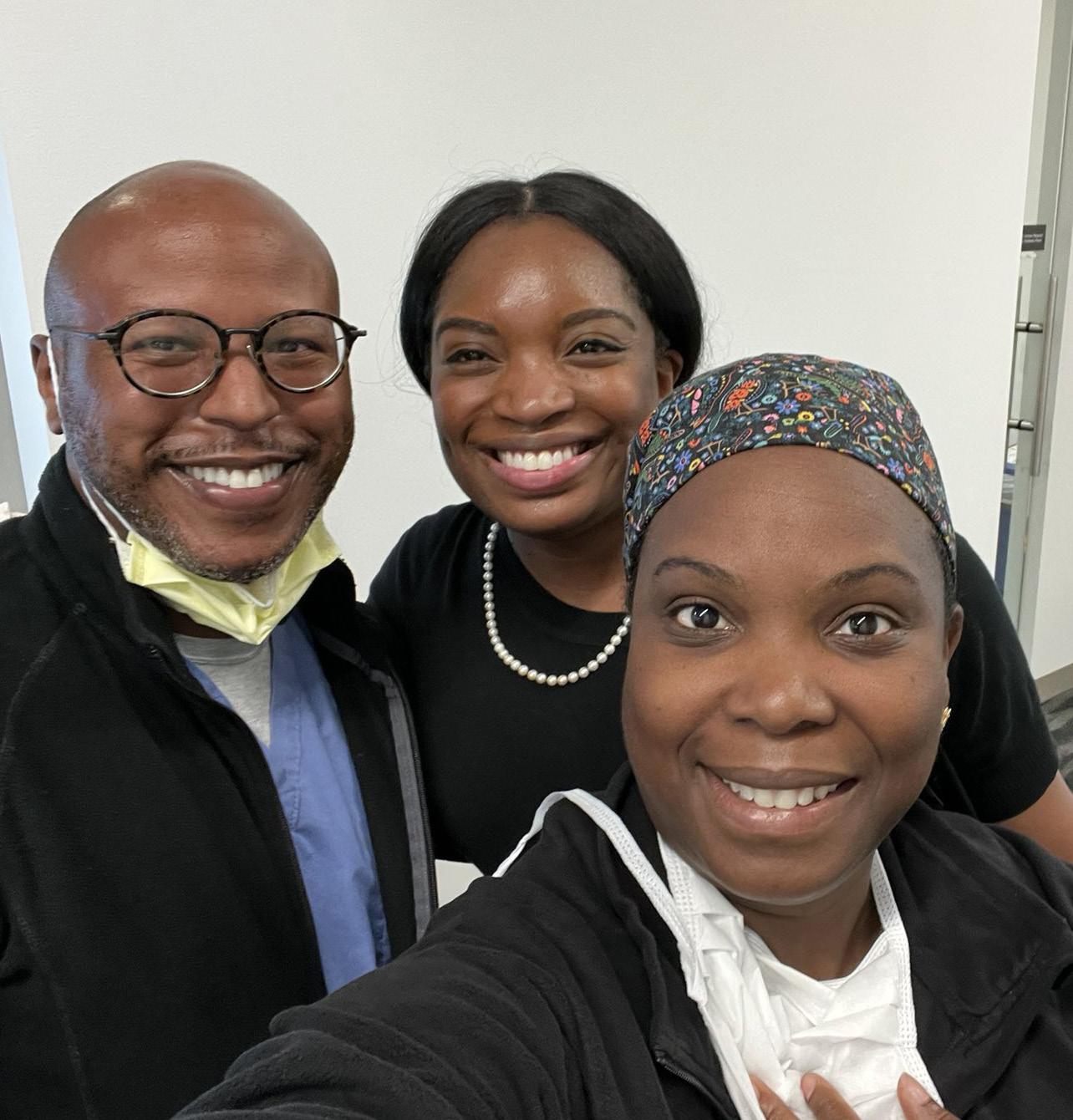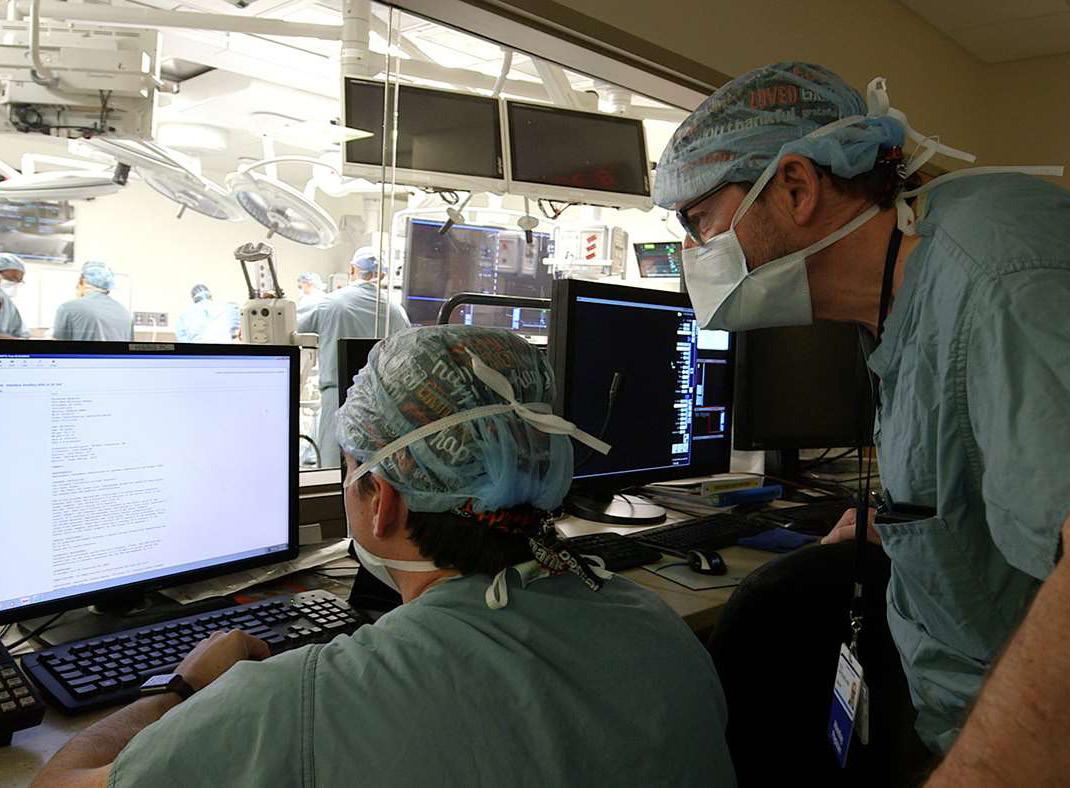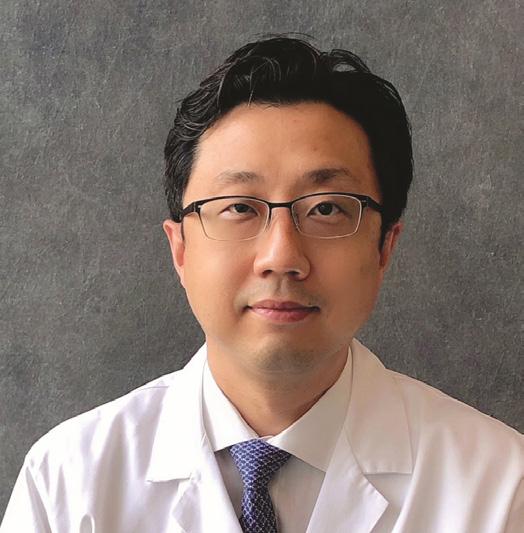
12 minute read
Researcher Spotlights
Read on to discover researcher spotlights for MCW faculty Callisia Clarke, MD, MS, David Joyce, MD, MBA, Christian Kastrup, PhD, Joohyun Kim, MD, PhD, and Anai Kothari, MD, MS.
Callisia N. Clarke, MD, MS
Associate Professor, Division of Surgical Oncology; Director of Advanced Skin Cancer Disease-Oriented Team
I completed my medical degree and general surgery residency at the University of Cincinnati Medical Center in Cincinnati. During my residency, I spent an additional 2 years dedicated to basic science research studying the role of CXC chemokines on hepatic ischemia reperfusion injury. I then completed a clinical fellowship in Complex General Surgical Oncology at University of Texas MD Anderson Cancer Center and an Oncology Research Fellowship where I focused on translational research in metastatic colorectal cancer using patient-derived xenografts, circulating tumor DNA and multi-omic tumor subtyping to identify novel therapeutic targets and predict tumor response to therapy.
I joined the faculty at the Medical College of Wisconsin in 2016 as an Assistant Professor of Surgery in the Division of Surgical Oncology with a clinical practice focused on neuroendocrine tumors (NETs) of the pancreas and GI tract, melanoma, and sarcoma. My research efforts are centered on epigenetic regulation of neuroendocrine tumors and are funded by a mentored NIH grant. Surgical oncology was the perfect field for me to marry my love of complex cancer cases and research inquiry. I chose to focus on NETs as these rare tumors are poorly understood and more progress is needed to make significant advances in the treatment of this disease. Our work is centered on understanding how epigenetic modulation of the tumor genome impacts tumor biology and response to treatment. We also investigate how the NET epigenome is affected by social determinants of health including ancestry and geolocation, and how these changes may affect long-term cancer outcomes.

Drs. Douglas Evans and Callisia Clarke in the OR.

Drs. Chad Barnes, Erin Strong, and Callisia Clarke.
David L. Joyce, MD, MBA
Professor, Division of Cardiothoracic Surgery

David L. Joyce, MD, MBA
My research career began as a PGY III resident in the laboratory of Michael E. DeBakey. I probably learned more in those two years than at any other time during my residency. Most of these lessons had to do with how to handle failure. I’m pretty sure I hold the world record for the number of botched Western blots, despite the fact that I had great mentorship and lots of support. I just wasn’t any good at doing research.
After completing my training, I spent three years in private practice followed by three years at the Mayo Clinic. This intensive clinical experience is not the typical path toward future academic success, but it helped me to understand more about the problems that needed to be solved. I also gained exposure to several new technologies that were being introduced to address some of the most significant clinical challenges we were facing at the time.
It wasn’t until I embarked on an Executive MBA program at the University of Chicago that I really began to connect the dots between problem identification, hypothesis formation, and translational research (also known as commercialization). An example of this “reverse engineering” approach to hypothesis formation can be found in our recent work on a VAD maintenance system. One of the most dangerous and dreaded operations in cardiac surgery involves the exchange of an LVAD. Patients, surgeons, and cardiologists are all in complete agreement that a less invasive alternative to this problem would be highly desirable. Coming up with a catheter-based treatment for this problem was definitely out of my wheelhouse, but I managed to put together a team that could work to find a solution to this problem. Without question, this is the single most gratifying part of doing research— running smack dab into a brick wall that you have no way to get around, only to discover what can happen with a little help from your friends.
To make a long story short, Hoplon (the startup company that was founded through this process) recently submitted a Direct to Phase II SBIR $1.8 million grant to the NHLBI after completing animal studies that were supported through We Care and Therapeutic Accelerator Program seed funding at MCW. Our device has been featured at ASAIO, STS, the Polsky Center New Venture Challenge, the Early-Stage Symposium, and the Wisconsin Governor’s Business Competition. Although we are still a long way from clinical trials, our entire team has gained tremendous confidence from the process of working through the NIH and FDA.

Drs. David and Lyle Joyce in the OR.
Christian Kastrup, PhD
Professor, Division of Trauma & Acute Care Surgery, Department of Surgery; Secondary appointments in the Departments of Biochemistry, Biomedical Engineering, and Pharmacology and Toxicology, Medical College of Wisconsin; Senior Investigator, Versiti Blood Research Institute

Christian Kastrup, PhD
I earned my degrees in Chemistry, receiving my B.S. in 2003 from the University of New Hampshire and my Ph.D. in 2008 from the University of Chicago. My PhD thesis focused on blood clotting, and uncovered biochemical and biophysical mechanisms that allow coagulation to seal injuries and prevent blood loss without spreading throughout our vasculature. I did my postdoctoral fellowship at MIT with Robert Langer, where I developed soft biomaterials to coat the inside of vessels. I also began working on RNAbased therapeutics and lipid nanoparticles. I started my independent research group at the University of British Columbia, and from 2011-2021 I trained over 75 postdocs, graduate, undergraduate, and medical students in my laboratory. In Fall 2021, I moved my research program to the Versiti Blood Research Institute (BRI) and MCW, where I am a Senior Investigator and Professor.
My primary research interest is advancing fundamental understanding of the biochemistry of blood coagulation, and engineering innovative therapies to control it. Research in my laboratory bridges hemostasis biochemistry, RNA therapy, nanomedicine, materials engineering and bioengineering. I am passionate about controlling blood clotting because hemorrhage is a leading killer of young people, and thrombosis is a serious risk in the days and weeks after trauma. My laboratory creates drug delivery systems and RNA therapeutics to address these issues. There are three main directions in my research program. The first is developing hemostatic materials for hemorrhage control, which includes powders and devices for non-compressible abdominal hemorrhage; we test these in models of severe hemorrhage. The second direction is developing RNA therapies for thrombotic and bleeding disorders, such as for understanding the role that specific proteins play in severe hemorrhage, and creating therapies to prevent post-trauma thrombosis. The third direction is creating a new cell therapy platform by engineering platelets to express exogenous proteins, which has many potential applications within and outside of trauma and surgery. We collaborate closely with the U.S. Army Institute of Surgical Research and the Canadian Armed Forces for these studies.
We have several projects on the brink of creating new medicines. We are nearing clinical trials with multiple technologies and have strong confidence that the results we are seeing in our advanced models will be translated to people. Both the device technologies we are developing to halt hemorrhage in trauma, and the RNA-based gene therapy approaches we are developing for hemostasis, are working extremely well in models and have relatively clear paths to clinical trials and approval. I am excited about the possibility of creating new approaches to extend survival after the most serious types of traumatic injuries. I want to help civilians and military service members buy time after severe injuries, so that they have the best chance of reaching a surgeon and receiving definitive care. With our technologies based on RNA gene-therapies, I see nearly limitless potential for gene therapy in modulating diseases of the blood and beyond. These are similar RNA and lipid nanoparticle therapies to those in the COVID-19 vaccines, and while I was not directly involved with the vaccine development, it has been exciting to see close colleagues and friends have such a huge impact on local and worldwide health. In addition to vaccines, these lipid-based nanomedicines can be used to knockdown almost any blood protein made in the liver and can also be used to express proteins in the liver – turning the liver into a bioreactor. Since most coagulation proteins are made in the liver, there is tremendous opportunity to create agents that modulate hemostasis, thrombosis and many other diseases.
Joohyun Kim, MD, PhD
Associate Professor, Division of Transplant Surgery

Joohyun Kim, MD, PhD
My research interest lies in liver injury and its repair. For example, cholestasis, which is dysfunctional bile production, always underlies the pathophysiology of various forms of liver surgery-associated hepatic dysfunction, such as post-hepatectomy liver failure, early allograft dysfunction after liver transplantation, or small-for-size syndrome in living donor liver transplantation.
I initiated collaborative studies during my fellowship at Seoul National University Hospital. We reviewed the immunohistochemistry staining of samples from liver transplantation recipients with pathologists and conducted an animal experiment study using MRI with hepatocyte-specific contrast with radiologists. Both studies suggested a strong association between liver injury and the function of hepatocyte membrane transporter proteins, which are responsible for cholestasis.
Since I joined MCW, I have had the opportunity to collaborate with outstanding scientists on this topic. The localization of transporter proteins along the cell membrane could be captured using a novel digital imaging analysis technique with Dr. Suresh Kumar (Pathology). The kinetics of fluorescent markers through transporter proteins could be monitored in real time using multispectral cameras with Dr. Amit Joshi (Bioengineering). Computational models were developed to determine the factors associated with the clearance of markers with Dr. Ranjan Dash and Dr. Said Audi (Bioengineering). The physical characterization of fluorescent dyes has been studied with Dr. Jacek Zielonka (Biophysics).
Combining all our efforts, objective quantification for the function of transporter proteins in livers became feasible. This research topic is timely, as ex vivo machine perfusion is now available in the clinical arena for liver transplantation. Currently, no device is available to assess liver function in an objective and reproducible manner. Based on the science and technology described above, it is possible to develop a liver function monitoring device for liver grafts before transplantation. Consequently, we established an ex vivo rat liver perfusion device with Dr. Yongqiang Yang (Transplant Surgery).
This novel approach could change clinical practice in liver transplantation by accurately predicting the outcome, so graft failure or unnecessary organ discard can be minimized. Furthermore, ex vivo machine perfusion gives an opportunity to resuscitate marginal organs to be transplantable by pre-transplantation targeted chemotherapy. We have investigated pharmaceutical interventions targeting cell survival signal pathways with Dr. Jong-In Park (Biochemistry). To develop this, a primary hepatocyte culture model with warm and cold hypoxia was established with Dr. Seung-Keun Hong (Transplant Surgery). In addition, the role of innate immunity and platelets during machine perfusion is also under study with Dr. Benjamin Gantner (Immunology) and Dr. Karin Hoffmeister (Versiti Blood Research Institute).
There is a consensus that the organ resuscitation technique is a paradigm shifter of liver transplantation practice. I am hopeful that we can contribute to this critical problem of our time, so we can open the next era of liver transplantation.

Joohyun Kim, MD, PhD, in the lab.
Anai N. Kothari, MD, MS
Assistant Professor, Division of Surgical Oncology Lab Director, AN.AI Lab

Anai N. Kothari, MD, MS
My interest in pursuing research started early as an undergraduate student at the University of Wisconsin–Madison investigating the fundamental properties of RNA polymerase. It served as a foundation for understanding the scientific process and the necessary rigor of experimental design to advance a research mission. During medical school, I gained my first exposure to clinical and health services research during a mentored summer fellowship in the Division of Thoracic Surgery at UW–Madison. This included experience with large-scale databases, database development, and predictive modeling. I further developed this foundation during a T32 research fellowship at Loyola University Chicago in the Oncology Institute. Through a partnership with DePaul University College of Computing and Digital Media, we developed a surgical analytics program that integrated data across multiple sources with the broad goal of understanding how to improve surgical care. During this time, I obtained a Master of Science degree in epidemiology with a focus on predictive analytics and machine learning.
I began developing the concept for the “Accelerating INsight. Augmented Intelligence Laboratory” (AN.AI Lab) during my clinical fellowship in Complex General Surgical Oncology at MD Anderson. There is tremendous excitement in many industries to identify ways to leverage artificial intelligence to improve common processes and advance society. Our lives are already impacted by the embrace of this kind of technology – for example, Apple, Google, Amazon, Netflix, and countless others use vast quantities of user-generated information to support a variety of applications we interact with throughout our day. Medicine and surgery, however, have been slow to adopt despite the massive amount of data generated through routine health care that includes electronic health records, registries, wearable devices, and other similar sources that could be used to support these efforts. With a push towards precision and personalized medicine, this is likely to change quickly (and already is). In cancer care, this has included a heavy reliance on augmented intelligence – which, unlike traditional artificial intelligence (that attempts to replace humans), emphasizes improving human abilities through the power of machine-generated insights. The overarching goal of AN.AI Lab is to improve health care delivery through clinical augmentation using data science approaches.
Currently the lab has 3 main areas of focus: (1) using real-world data (including the All of Us Research Workbench and National COVID Cohort Collaborative Data Enclave) to predict clinical outcomes; (2) developing an integrated data resource to support cancer research across the state; (3) applying deep learning methodologies to better utilize intraoperative data. Ultimately, findings from these efforts (and others) will be paired with informatics-based tools to help directly impact patient care.

The AN.AI Lab Team at work.









